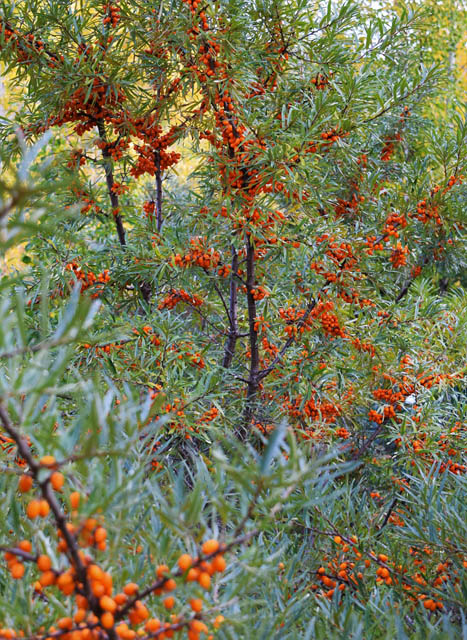by MONICA MARCU
Everybody visiting our orchard is surprised to see and asks about a beautiful, strange tree, with shiny silvery leaves and bright-orange, berry-like fruits gathered in rich clusters. Most North Americans are not used to it, as this tree is originally from Central Asia and does not grow here wild. In fact, it is very rare and uncommon, but you better be ready, sea buckthorn is coming, and coming strongly to Canada and everywhere else.
I want to introduce you to a most unique and wonderful nutritive and medicinal plant that can grow well in most climates — from Alaska to the desert — and most altitudes, from sea level to the high mountains.
It can withstand drought, and it can survive at –50°C.
Sea buckthorn — Hippophae Rhamnoides — meaning bright shining horse, is a very hardy plant, which grows well even here, in this cold climate. Interestingly, sea buckthorn berries can stay on the branches throughout the winter, thus attracting and providing food for birds and small animals. Our favorite way to harvest the berries is actually in winter, when they are frozen and can be easily picked without breaking the fragile skin.
But there is more than resilience: the tree rapidly develops an extensive root system (which fixes nitrogen and enriches the soil) and is an ideal plant for preventing soil erosion and land reclamation, and it is an attractive ornamental tree.
This outstanding tree was used for centuries in Europe and Asia, and many drugs have been made from it in Russia and China.
In the eighth century the Tibetan medical books described it as containing over 190 nutritional compounds in the berries, seeds and leaves.

Today the science has shown that each of these compounds can be effective on its own, but it is their synergy, which makes sea buckthorn a powerful source of nutrients. The berries are like hanging natural multivitamins, and remember, devoid of any dangerous additives such as those found in man-made pills.
Sea buckthorn can be used for many things, and has momentous economic potential even in Canada. The fruits are not particularly sweet, but rather tangy, and are rich in proteins, organic acids, antioxidants and vitamins. Vitamin C in berries is high (100–300 mg/100 g), more than in orange, strawberry or kiwi, while vitamin E content is higher than in wheat embryo or soybean.
The most valuable medicinal properties of sea buckthorn (fruit and oil) are: anti-inflammatory, anti-aging (used in cosmetics), antimicrobial (antibiotic), pain relief, and regenerative of various tissues, especially after burns or radiation damage.
After the 1986 nuclear accident, many of the Chernobyl disaster victims were treated with sea buckthorn. The oil extracted from this plant is used currently in Russian hospitals.
In many countries, various products are made from sea buckthorn, such as beverages and jam from berries, tea from leaves, fermented products from pulp, and animal feed from pulp residue.
Ah, and expensive beauty products for hair and skin.
The name of the plant was coined in ancient times after noticing that feeding the leaves to horses improved their health and made their hair shiny.
We don’t have horses, so we cannot guarantee it is true, but we use to add the berries to other fruits when preparing smoothies. All our animals love these berries.
Sea buckthorn has been recommended for orchard-type cultivation in British Columbia and the prairies.
By all accounts, sea buckthorn is a unique, highly valuable plant being domesticated in various parts of the world.
It is easily propagated, yields are high, and production is reliable. The plant is recognized as one of the most promising plants for nutrition and cosmetics, and even demonstrated potent antiviral properties in humans and birds.



